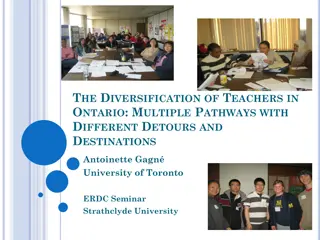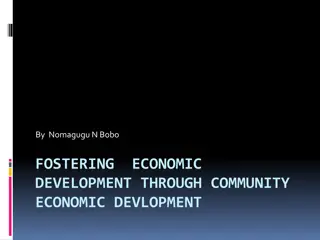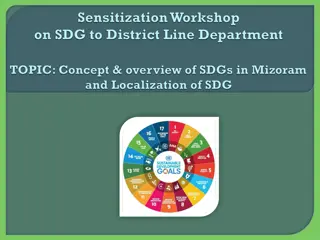Achieving Sustainable Development Through Economic Diversification
The director of the Research Department at the Central Bank of Nigeria discusses the need for enhanced diversification of the economy for sustainable development and the implementation of the SDGs. Highlighting challenges such as recession, negative GDP growth, rising inflation, and unemployment, the emphasis is on the importance of broadening sources of national wealth, reducing reliance on vulnerable sectors like oil, and promoting inclusive growth through economic diversification.
Download Presentation

Please find below an Image/Link to download the presentation.
The content on the website is provided AS IS for your information and personal use only. It may not be sold, licensed, or shared on other websites without obtaining consent from the author. Download presentation by click this link. If you encounter any issues during the download, it is possible that the publisher has removed the file from their server.
E N D
Presentation Transcript
4THTECHNICAL SESSION ON THE ENHANCED DIVERSIFICATION OF THE ECONOMY FOR SUSTAINABLE DEVELOPMENT AND IMPLEMENTATION OF THE SDGs TALKING POINTS UWATT BASSEY UWATT, Ph.D DIRECTOR, RESEARCH DEPARTMENT, CENTRAL BANK OF NIGERIA 15THMEETING OF THE 2016 JOINT PLANNING BOARD(JPB) AND NATIONAL COUNCIL ON DEVELOPMENT PLANNING (NCDP) TUESDAY 23RD THURSDAY, 25TH AUGUST, 2016, KANO, KANO STATE
OUTLINE 1. Preamble 2. Where we are 3. What we need to do 4. Focus Areas/ Specific Policy Actions 1
1. Preamble In any economy, economic management is concerned with deliberate actions/efforts to: Expand the total wealth of a nation at a very fast rate economic growth Ensure that the wealth are equitably distributed and that the gab between the highest and lowest beneficiary of the national wealth is not uncontrollably wide- reduce poverty and inequality Provide decent jobs for all citizens who are willing and able to work Provide equal opportunities for all citizens to excel in their chosen carriers Prevent overconsumption of natural resources needed by future generations Ensure existence of strong social, economic and political institutions for policy formulation and implementation, etc. All these can be achieved if there is concerted efforts to increase the resilience of the economy by: Broadening the sources of the national wealth Reducing reliance on vulnerable economic sectors, such as oil in Nigeria 2
1. Preamble Increasing the range and number of economic outputs produced Diversification of markets for exports Diversification of income sources away from domestic economic activities Increase the variety of products and/or practices within an economic activity The first part talks about sustainable and inclusive growth while the second part is concerned with diversification of the economy. If the two parts are appropriately pursued, it will lead to the achievements of the Sustainable Development Goals (SDGs) 3
2. Presently, the economy is facing serious challenges: Technically in recession Negative GDP growth in Q1 (-0.36%) and Q2 () Rising Inflation rate, currently at 16.48% Dwindling External Reserves Rising Unemployment/Underemployment Falling Government Revenue Infrastructure Deficit Security Challenges, etc. The economy is not equally sufficiently diversified. The growth we have witnessed in the past decade is to say the least not inclusive paradox of growth with increasing poverty, inequality and high unemployment. The numbers speak for themselves. Where We Are 4
2. Where We Are Table 1: NIGERIA ECONOMIC AND SOCIAL INDICATORS Table 2: NIGERIA - GLOBAL COMPETITIVENESS INDEX, 2016 A. ECONOMIC INDICATORS Real GDP (N Billion -2015) CONTRIBUTION TO GDP (%) (2015) Agriculture Industries Crude oil and natural gas Solid Minerals Manufacturing Services Construction Trade Other services Oil Non-oil B. SOCIAL INDICATORS HDI( 2013) IHDI (2013) GNI per capita (2011ppp$-2013) GNI Index (2013) Life Expectancy at birth (in years - 2013) Life Expectancy index (2013) Mean years of scholling < 5 mortality rate ( per 1000 life births - 2013) Educational index (2013) Multi-dimensional Poverty iIndex (mPI-2013) Unemployment ( %-2015) Sources: UNDP and NBS INDICATORS GCI 2015-2016 (124/140) BASIC REQUIREMENT (136/140) 1st Pillar: Institutions (124/140) Diversion of public funds (132/140) Public trust in politicians ((132/140) Favoritism in decisions of government officials (132/140) Wastefullness of government spending (131/140) 2nd Pillar: Infrastructure (133/140) Quality of railroad infrastructure (103/140) Quality of electricity supply ((139/140) Fixed-telephone lines/100 pop ((139/140) 3rd Pillar: Macroeconomic environment (81/140) 4th Pillar: Health and primary education (140/140) EFFICIENCY ENHANCERS (81/140) 5th Pillar: higher education and training (128/140) 6th Pillar: Goods market efficiency (100/140) 7th Pillar: Labour market efficiency (35/140) 8th Pillar: Financial market development (79/140) 9th Pillar: Technological readiness (106/140) 10th Pillar: Market size (25/140) INNOVATION AND SOPHISTICATION (114/140) 11th Pillar: Business sophistication (94/140) 12th Pillar: Innovation (117/140) Source: World Economic Forum Score (1-7) 3.5 3.2 3.2 2.1 1.7 2.1 2.2 2.1 1.5 1.4 0.1 4.6 2.9 3.9 2.8 4.1 4.5 3.8 3 5.1 3.2 3.7 2.8 69,023.93 23.11 19.8 9.61 0.15 10.04 57 3.9 16.9 36.2 9.61 90.39 0.504 0.3 5353 0.601 52.5 0.5 5.2 124 0.8139 0.247 27.5 5
2. Where We Are Table 3. THE MOST PROBLEMATIC FACTORS FOR DOING BUSINESS IN NIGERIA Score 26.5 19.7 12.7 8.7 8.4 4.8 4.4 3.4 2.6 2.0 1.9 1.8 1.6 0.6 0.5 0.3 Inadequate supply of infrastructure Corruption Access tio financing Policy instability Inefficient government bureaucracy Foreign currency regulation Inadequate educational workforce Inflation Poor work ethics in labour force Tax rates Complexity of tax regulations Insufficient capacity to innovate Crime and theft Restrictive labour regulations Poor public health Government instability/coups Source: World Economic Forum, GCI 2016 6
2. Where We Are Table 4. DOCUMENTED DRIVERS OF POVERTY IN NIGERIA 1. Low and decling real farm income 2. Higher prices of food and other essentials like transport, fuel (lower real income) 3. Macroeconomic conditions - exchange rate, interest rate (access to credit), jobless and non-inclusive growth (gender issues in growth), inequality, unemployment and high dependence on oil 4. Socio-cultural conditions 5. insecurity ( conflict and displacement of populations) 6. Stagnating rural economy (agriculture, infrastructure, insecurity, natural disasters) 7. Gender imbalance (inequality of access to basic entitlements, education, health, sanitation, energy, housing) 8. policy shocks Source: UNDP, HDR, Nigeria 2016 7
2. Where We Are Table 5: SUSTAINABLE DEVELOPMENT GOALS S/N GOALS No Poverty Zero Hunger Good Health and Well-Being Quality Education Gender Equality Clean Water and Sanitation Affordable and Clean Energy OBJECTIVES End poverty in all its forms every where End hunger, achieve food security and improved nutrition and promote sustainable agriculture Ensure Healthy Lives and promote well-being for all ages Ensure inclusive and equitable quality education and promote life-long learning opportunities for all Achieve gender equality and empower all women and girls Ensure availability and sustainable management of water and sanitation for all Ensure access to affordable, reliable, sustainable and morden energy for all Promote sustained, inclusive and sustainable economic growth, full and productive employment and decent work for all. Build resilient infrastructure, promote inclusive and industrialization and foster innovation Reduce inequality within and among countries Make cities and human settlements inclusive, safe, resilient and sustainable Responsible Consumption and Production Ensure sustainable consumption and production patterns Climate Action Take urgent action to combat climate change and its impacts Life Below Water Conserve and suatainably use the oceans, seas and marine resources for sustainable development 1 2 3 4 5 6 7 8 9 Decent Work and Economic Growth Industry, Innovation and Infrastructure Reduced inequality Sustainable Cities and Communities 10 11 12 13 14 Project, restore and promote sustainable use of terrestial ecosystems, sustainably manage forests, combat desertification, and halt and reverse land degradation and halt biodiversity loss Promote peaceful and inclusive societies for sustainable development, provide acess to justice for all and build effective, accountable and inclusive institutions at all levels Strengthen the means of implementation and revitalize the global partnership for sustainable development 15 Life on Land 8 16 Peace, Justice and Strong Institutions 17 Partnership for the Goals
3. What We Need To Do Achieving SDGs will be very difficult unless deliberate actions are taken to ensure inclusive growth and diversification of the economy. The way out is for us to return to the development planning era with appropriate implementation strategies short-, medium-, and long- term strategies. We need to harmonize all the existing sectoral plans/programmes into a single implementable plan. Since 1999, we have had several initiatives such as NEEDs (SEEDS,LEEDS) 2003-2007; Seven Point Agenda- 2007-2011, Vision 20:2020, Transformation Agenda-2011- 2015; Agricultural Promotion Policy (The Green Initiative) and the Power Sector Road Map for Change 2015-date. Given that the economy is presently in a sorry state, the immediate action would be to declare an Economic State of Emergency while the various strategies are being finalized. 9
4. Focus Areas/Specific Policy Actions Priority Sectors Agriculture Manufacturing Building and construction Power Infrastructure (roads, rail, water, etc.) Social Services (education, health, safety nets) Security Expansion in Revenue/Other Funding Sources Borrowing (Domestic/External) Asset Disposal Concessioning/PPP Expenditure Switching Measures Quotas, tariffs, restrictions, exchange rate policies, etc. Expenditure Changing Measures Fiscal Stimulus by: Payment of outstanding salaries to all tier of government employees Social safety nets: conditional transfers, school feeding programmes, etc. Outstanding domestic contractual debts, etc. Reduction in cost of governance- Civil Service reforms Streamline MDAs, ghost workers, overheads, travels, process re-engineering, etc. 10
4. Focus Areas/Specific Policy Actions Contd. Institutional Reforms Address challenges to efficient performance of the judiciary, public service and revenue generating agencies Establishment of special courts for corruption cases Legislation Issues Executive-Legislative Dialogue Address legislative constraints Fiscal Responsibility Act (FRA) Section 44, Part X (Conditions of borrowing and verification of compliance with limits). Public Procurement Act (PPA) - Fast-track project approval and procurement process. NNPC (Non-passage of the PIB) DMO (Domestic-external debt mix) 13
THANK YOU 13























